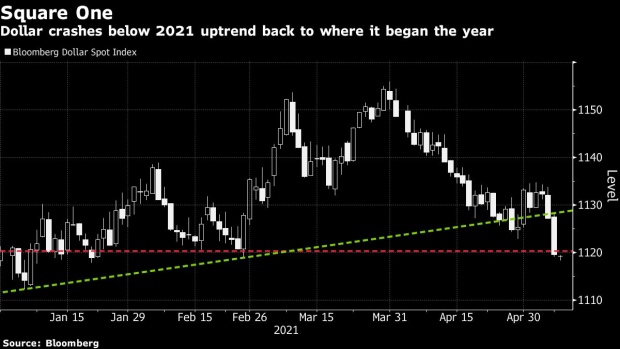May 9, 2021
Dollar Back to Where It Began the Year as Rally Burns Out
, Bloomberg News

(Bloomberg) -- It’s back to square one for the dollar.
After Friday’s worse-than-expected U.S. employment data, the Bloomberg Dollar Spot Index slumped definitively out of its 2021 uptrend and is back to little changed for the year. Posting its biggest one-day fall in five months, the greenback is now at risk of a decline toward its lowest since February 2018.
The data miss is the latest blow to the world’s reserve currency that saw a brief early-year revival snuffed out by retreating Treasury yields, improving sentiment toward economies outside the U.S. and a dovish Federal Reserve. The dollar gauge has fallen almost 14% from a record high last March, and the likes of JPMorgan Asset Management and T. Rowe Price are predicting more losses ahead as the global economy recovers.
“We continue to see the ‘peaking U.S. exceptionalism’ narrative playing out through a weaker dollar over time,” Citigroup Inc. strategists including Ebrahim Rahbari wrote in a note. That’s thanks to “views on a dovish Fed, benign risk appetite and a global recovery.”
The dollar’s reversal gives some vindication to Wall Street bears who called for a weaker currency in January, but were left scrambling to cover their short positions when better-than-expected U.S. data pushed Treasury yields higher. That move has also faded with benchmark yields down about 18 basis points from their 1.77% high in March, denting one of the biggest appeals of the greenback.
Selling the U.S. currency is now back in vogue, with aggregate net short positions versus major peers growing to about $10 billion last week from $4 billion in mid-April, according to the latest data from the Commodity Futures Trading Commission. Bearish bets totaled almost $31 billion in January.
“We expect the dollar to weaken further, given its diminishing appeal as a safe-haven currency as long as the global economic picture and risk appetite improve further,” UniCredit S.p.A. strategist Roberto Mialich wrote in a note Friday.
©2021 Bloomberg L.P.


